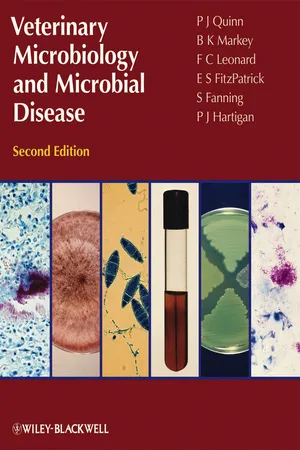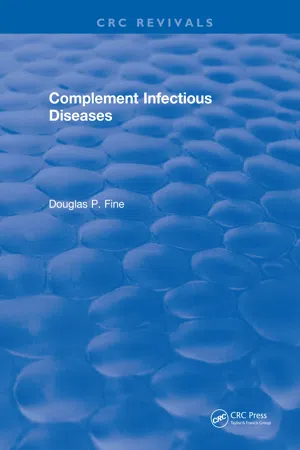Biological Sciences
Gram-Negative Bacteria
Gram-negative bacteria are a group of bacteria that have a unique cell wall structure, which includes an outer membrane containing lipopolysaccharides. This outer membrane makes them more resistant to antibiotics and immune system attacks. Gram-negative bacteria are known for causing a wide range of infections, including pneumonia, urinary tract infections, and bloodstream infections.
Written by Perlego with AI-assistance
Related key terms
5 Key excerpts on "Gram-Negative Bacteria"
- eBook - ePub
- P. J. Quinn, B. K. Markey, F. C. Leonard, P. Hartigan, S. Fanning, E. S. Fitzpatrick(Authors)
- 2011(Publication Date)
- Wiley-Blackwell(Publisher)
Also known as fimbria (plural, fimbriae). Thin, straight, thread-like structures present on many Gram-Negative Bacteria. Two types exist, attachment pili and conjugation pili Chromosome DNA Single circular structure without nuclear membrane Ribosome RNA and protein Involved in protein synthesis Storage granules or inclusions Chemical composition variable Present in some bacterial cells; may be composed of polyphosphate (volutin or metachromatic granules), poly-beta-hydroxybutyrate (reserve energy source), glycogenThe outer membrane of Gram-Negative Bacteria is a protein-containing asymmetrical lipid bilayer. The structure of the inner surface of the membrane resembles that of the cytoplasmic membrane, whereas that of the outer surface is composed of lipopolysaccharide (LPS) molecules. Low molecular weight substances such as sugars and amino acids enter through specialized protein channels, known as porins, in the outer membrane. The outer membrane LPS, the endotoxin of Gram-Negative Bacteria, is released only after cell lysis. The major components of LPS molecules are core polysaccharides bound to lipid A and long external polysaccharide side chains. The polysaccharide side chains of the LPS molecules stimulate antibody production and correspond to the somatic (O) antigens used for serotyping of Gram-negative cells. Lipid A is the molecular component in which endotoxic activity resides. On account of its composition, the outer membrane excludes hydrophobic molecules and renders Gram-Negative Bacteria resistant to some detergents which are lethal to most Gram-positive bacteria. Comparative features of the cell walls of Gram-positive and Gram-Negative Bacteria are illustrated in Fig. 7.3 .The mycoplasmas comprise an important group of bacteria without cell walls. Conventional bacteria, exposed to the action of antibiotics such as penicillin, or other substances which interfere with the synthesis of peptidoglycan, cannot produce cell walls and are termed L forms. - eBook - ePub
Microbial Food Safety
A Food Systems Approach
- Charlene Wolf-Hall, William Nganje(Authors)
- 2017(Publication Date)
- CAB International(Publisher)
6 Gram-Positive BacteriaKey Questions• Which Gram-positive bacteria are of most concern for microbial food safety?• What are the mechanisms by which these Gram-positive bacteria cause illness?• What are the hazards these Gram-positive bacteria present to consumers?• What controls are available to prevent foodborne illness due to these Gram-positive bacteria?The Difference Between Gram-Positive and Gram-Negative Bacteria
Hans Christian Gram was the Danish scientist who, in 1884, published a method for a staining technique to help better see bacteria in tissue samples under the microscope. An unanticipated result of this technique was a way to differentiate two major groups of bacteria based on their cell wall compositions.Bacterial cell membranes that contain thick layers of peptidoglycan are able to retain the crystal violet stain used in the method, resulting in purple- or violet-stained cells that are described as Gram positive. Bacteria that contain less peptidoglycan in their cell membranes are unable to retain the crystal violet stain after the destaining step of the procedure, and as a result of counter-staining with safranin dye appear red or pink, and are described as Gram negative. As with all microbiological testing methods, there are limitations and some bacterial species may produce Gram-variable results, indicating an ability to stain with either reaction result and not provide a clear distinctive result.Gram staining is a preliminary test used on bacterial cultures to give clues to the identity of the species. The Gram reaction is a first clue, and then other clues like the microscopic cell morphology or shape and placement can provide other clues. The remainder of this chapter will focus on those bacterial pathogens of most concern in foods that fall under the category of Gram positive, and Chapter 7 - eBook - ePub
- Douglas P. Fine(Author)
- 2018(Publication Date)
- CRC Press(Publisher)
Chapter 3BACTERIAI. Classification
Bacteria belong to the kingdom Procaryotae . The reader not especially versed in microbiology may find it useful to refer to Table 1 , which is adapted from Bergey’s Manual of Determinative Bacteriology ,1 and lists bacteria pathogenic for man or otherwise referred to in this text. For convenience, the discussion of interactions of bacteria with the complement system will follow the outline of this table.II. Bacterial Surfaces
Because the interaction with complement occurs at the microbial surface, it is important to review some of the information regarding that surface. This subject is, of course, worthy of extensive reviews of its own; numerous articles and books have been published.2 , 3A. Cell Membrane
Bacteria are, like all cells, limited by a metabolically active and complex cell membrane. This lipid bilayer maintains the osmotic and ionic integrity of the cell by virtue of its molecular transport function. The membrane is also a major site of synthesis of cellular products.4B. Cell Wall
Outside the relatively fragile cell membrane is the cell wall, a tough, semirigid envelope which protects the bacterium in a sometimes hostile world. The sine qua non of this exoskeleton is a polymer known variously as peptidoglycan, glycopeptide, mucopeptide, glycosaminopeptide, and murein. The two glycans, N -acetylglucosamine and N -acetylmuramic acid, are linked through peptide side chains so as to compose “a single, enormous macromolecule that forms a more-or-less continuous network around the cellular permeability barrier and provides the cell with a supporting structure of high tensile strength.”5 The glycan portion varies only slightly among bacteria, whereas variations in the peptide moieties contribute greatly to characteristics of bacterial strains and species.5 , 6Many bacteria can be segregated on the basis of the Gram stain. Gram-positive organisms retain the dye crystal violet; in contrast, the dye is washed out of Gramnegative bacteria by acetone-alcohol. This seemingly trivial difference reflects profound differences in biological behavior between Gram-positive and Gram-Negative Bacteria. To a great extent, these differences are due to the structure of the respective cell walls. - eBook - ePub
Microbiology and Molecular Diagnosis in Pathology
A Comprehensive Review for Board Preparation, Certification and Clinical Practice
- Audrey Wanger, Violeta Chavez, Richard Huang, Amer Wahed, Amitava Dasgupta, Jeffrey K. Actor(Authors)
- 2017(Publication Date)
- Elsevier(Publisher)
Chapter 6Overview of Bacteria
Abstract
This chapter will deal with all common Gram-positive and Gram-Negative Bacteria, as well as Enterobacteriaceae, anaerobes, and mycobacteria and their role in infective patients. Drugs which are used in treating such infections will also be addressed.Keywords
Bacterial infections; Gram positive; Gram negative; Enterobacteriaceae; anaerobes; mycobacteriaContentsIntroduction 76Diagnostic Approach 77Gram-Positive Bacteria 77Coagulase positive Staphylococcus78Staphylococcus species Not Staphylococcus aureus78Streptococci 79Mutans group (e.g., Streptococcus mutans )83Salivarius group (e.g., Streptococcus salivarius )83Anginosus group (e.g., Streptococcus anginosis )83Catalase negative gram-positive cocci 83Vancomycin resistant gram-positive cocci 84Gram-Positive Bacilli 84Gram positive, endospore-forming bacilli 87Aerobic gram positive, nonendospore-forming bacilli 87Weakly acid fast bacteria 88Nocardia spp.89Streptomyces89Rhodococcus spp.89Mycobacteria spp.89Nontuberculous mycobacteria 91Photochromogens 91Scotochromogens 92Nonphotochromogens 92Rapid growers—Mycobacterium fortuitum , Mycobacterium chelonae/Mycobacterium abscessus, Mycobacterium mucogenicum92Skin mycobacteria—Mycobacterium marinum, Mycobacterium haemophilum , and Mycobacterium ulcerans93Gram-Negative Bacteria 93Lactose fermenters 95Slow/nonlactose fermenters 96Nonenterobacteriaceae 97Neisseria spp.98Gram-Negative Bacilli 99Pseudomonas aeruginosa99Burkholderia spp.99Vibrio100Aeromonas100Plesiomonas shigelloides100Fastidious gram-negative rods 101HACEK organisms: Aggregatibacter - eBook - ePub
Scott-Brown's Otorhinolaryngology and Head and Neck Surgery
Volume 1: Basic Sciences, Endocrine Surgery, Rhinology
- John Watkinson, Ray Clarke, John C Watkinson, Ray W Clarke(Authors)
- 2018(Publication Date)
- CRC Press(Publisher)
MicrobiologyCHAPTER 19Microorganisms
Ursula Altmeyer, Penelope Redding and Nitish KhannaIntroduction Basic concepts in microbiology Classification of bacterial organisms ReferencesSEARCH STRATEGYThis chapter collates basic consensus knowledge of bacteriology. Laboratory practices described are based on Public Health England’s Standards for Microbiology Investigations (SMI). Data in this chapter may be updated by a PubMed search using the keywords: basic concepts in microbiology; classification of bacteria based on gram staining; gram positive; gram negative; staphylococci, streptococci, enterobacteriaceae, anaerobes; mycobacteriae; spirochetes.INTRODUCTION
The human body is a habitat that supports single-cell microorganisms in numbers that by far exceed the number of its own cells. Most of these organisms have evolved over millions of years in close association with our own species, forming what is referred to as the human microbiome.Contained in their ecological niche, these bacteria can be essential for the survival of the host body, although if given the opportunity to leave their niche, for example through injury or surgery, their presence may equally lead to disease. Some of these beneficial, or at least harmless, tenants also have the potential to cause opportunistic infections in host organisms that are particularly susceptible, whether that be due to overall poor health, extremes of age, or constitutional or iatrogenic immunosuppression.
Index pages curate the most relevant extracts from our library of academic textbooks. They’ve been created using an in-house natural language model (NLM), each adding context and meaning to key research topics.




